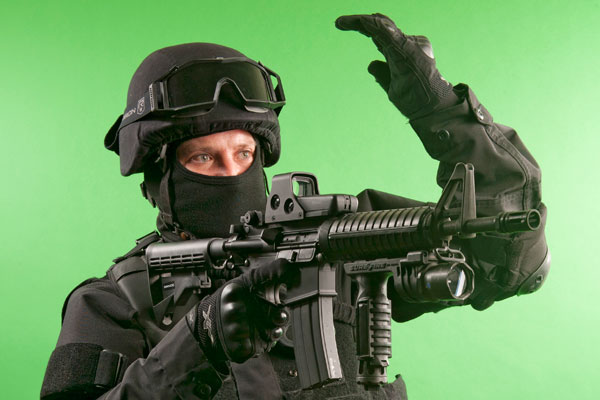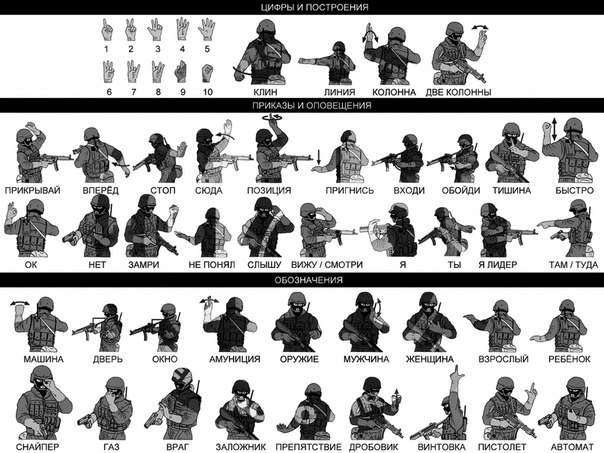Tactical hand signals

Before performing the tactical task of the group there is a problem of mutual understanding and communication. Naturally, with the search activities, no one will be in full voice to discuss the sequence of the doorway, the options for stripping corners, or to inform partners that a suspect is around the corner. Meanwhile, without the exchange of information is indispensable, and it will be transmitted through non-verbal communication.
The means of nonverbal communication of paramount importance is physical contact with the partner, thanks to which the direction of his movement is literally felt and accordingly the conclusion is made about which zone he controls. If someone notices something suspicious, the simplest thing is to put a hand on the partner's shoulder or stop him, grabbing him by the waistband.
Sign language is used for the transmission of abstract signals. The following variants of signals submitted by hands are divided into two parts. The first is a simplified, consisting of a small number of basic signal gestures, for law enforcement officers who are not members of the special groups, but in the service of the team, who are faced with problems of teamwork. The second option is a system of signs of special SWAT units that use the real sign language.
Attention! For non-verbal communication, only a weapon-free arm should be used, and the barrel of the weapon must always be pointed at the danger zone.
27 basic signals / gestures for tactical groups

- "I'm ready" - the signal is used to attract attention, (the hand is raised upwards, and you wave simply, back and forth, it seems, when we greet the friend)
- "I understand" - the gesture is used, the code fighter took the information, or completed the task, and is ready to proceed. (Thumb Up)
- "I did not understand" - the gesture says that the fighter did not accept the information. (The hand rises to the level of the face, and the palm outwards, we drive it, in front of the ear, to the nose).
- "Stop the fire" is a gesture for an immediate cease-fire. (Palm out, you drive your hand in front of your face, up and down).
- "Forward" means all members of the group have to move the beliefs. (The arm rises, and a swing is done in the direction.) You can use your arm bent at the elbow.
- "Stop" - the group stops moving, but the fighters can move into the shelter. (The signal is fed with an open palm towards the recipient, as if you are refusing something).
- "Zamri" - this signal means to freeze in the literal sense of the word. Do not run into shelter, do not fall to the ground, nothing at all. This signal is given, when an enemy patrol passes nearby, or the whole squad is already in the minefield. (The signal is raised, and with a bent hand, with a clenched fist.)
- "Duck" means to stoop to the ground. (It is given by movement of a hand, with an open palm, from top to bottom)
- "To rise" is the opposite, to the signal "to duck" (the movement of the hand from the bottom upwards is given)
- "Increase the interval" - this signal is given when the unit enters an open area, to increase the distance in the formation, or between formations. (Serves up with two hands up.) Raise the palms to the sides.)
- "Reduce the interval" - served before the entrance of the patrol in a dense area, or, before a decisive attack of enemy positions, with the transition to close combat. (It is given by the hands lifted upwards, palms are reduced together).
- "The movement of the column" means the whole detachment is following the guide. (The hand rises and waves backward, this signal is the exact opposite of "Leave").
- "Wedge" - the attacking system. So the fighters must build a wedge from the fighting links, and prepare to attack. (The signal is given, slightly raised with straight hands from the feet, it looks like an inverted "V".
- "Movement in the line" - the attacking system. They give before the decisive attack positions of the enemy., That would detachment lined up on the sides of the guide. (Hands are bred to the sides at shoulder level.
- "Danger Zone" - is served most often, in front of an open area, or a glade. (The signal is fed by a chopping motion from the neck to the palm).
- "Traffic under cover" - this signal means that the group will cross the open areas of the shoulder-to-shoulder (This gesture is given by double tapping on the left shoulder, make sure everyone sees your left shoulder)
- "Report on the distance covered by the patrol", - in meters. (To do this, you have to pat yourself, on any shoe). In the day, show your fingers a distance, 1 finger - 100 meters. At night in the ear.
- "Report on the number" - to assess the number of the enemy, and assess the degree of danger. (For this you need to pat on the top of the head). In the afternoon, the number is shown with your fingers, at night in your ear.
- "Patrol commander - forward" - this means that the patrol commander must go to the vanguard. (Here you have to pat yourself on the forehead, patting on the chest means - forward squad leader, and on the groin commander of the link.)
- "Intelligence forward" is a command for reconnaissance patrol. (We show the two fingers from the eyes forward.)
- "To gather around me" means that the soldiers must surround the pointing in the circular defense. (Pull your arm up, and draw a circle over your head).
- "Assembly point" - this signal means a certain collection point, it can be a stone, a fallen tree, a ravine. (Draw a circle above your head, and throw your hand in the direction of the collection point)
- "Running" - the patrol passes to easy running. (Raise the arm bent at the elbow, clench the fist, and move the hand up and down).
- "Step" - the patrol goes one step further. (We stretch the hand to the side, palm down, and move the hand up and down)
- "Prepare" means that the patrol must prepare for contact (but not open fire), with the enemy, in the specified direction. (As if pounding their fists, in the direction of the enemy).
- "Opponent" - is shown, only when the presence of the enemy is confirmed. (Show, at a short distance with the index finger, on the long, the machine above the head rises with the magazine up.)
- "Numbers" - are shown with fingers. (100 - one finger, if the distance is reported, and 1 tank, if you report on the amount of equipment.)
OPTION SWAT
 |
 |
 |
 |
 |
| one | two | three | four | five |
 |
 |
 |
 |
 |
| six | seven | eight | nine | ten |
 |
 |
 |
| You | I (Me) | Go here (here) |
 |
 |
 |
| I hear (listen) | I see (look) | Faster |
 |
 |
 |
| Stop | To die | This sector |
 |
 |
 |
| We are moving forward (approach) | Enemy | Hostage |
 |
 |
 |
| Sniper | Let | I take the leader |
 |
 |
 |
| In the column (battle formation) | In a row (battle order) | In the line (battle order) |
 |
 |
 |
| Wedge (battle formation) | Collection (all of me) | Pistol |
 |
 |
 |
| Rifle | Automatic (pump) | Ammunition (equipment) |
 |
 |
 |
| Transport | I got it | Do not understand |
 |
 |
 |
| Moving bent down
(To duck down) |
Door | Window |
 | ||
| Place of entry (eg) | ||


Comments
When commenting on, remember that the content and tone of your message can hurt the feelings of real people, show respect and tolerance to your interlocutors even if you do not share their opinion, your behavior in the conditions of freedom of expression and anonymity provided by the Internet, changes Not only virtual, but also the real world. All comments are hidden from the index, spam is controlled.